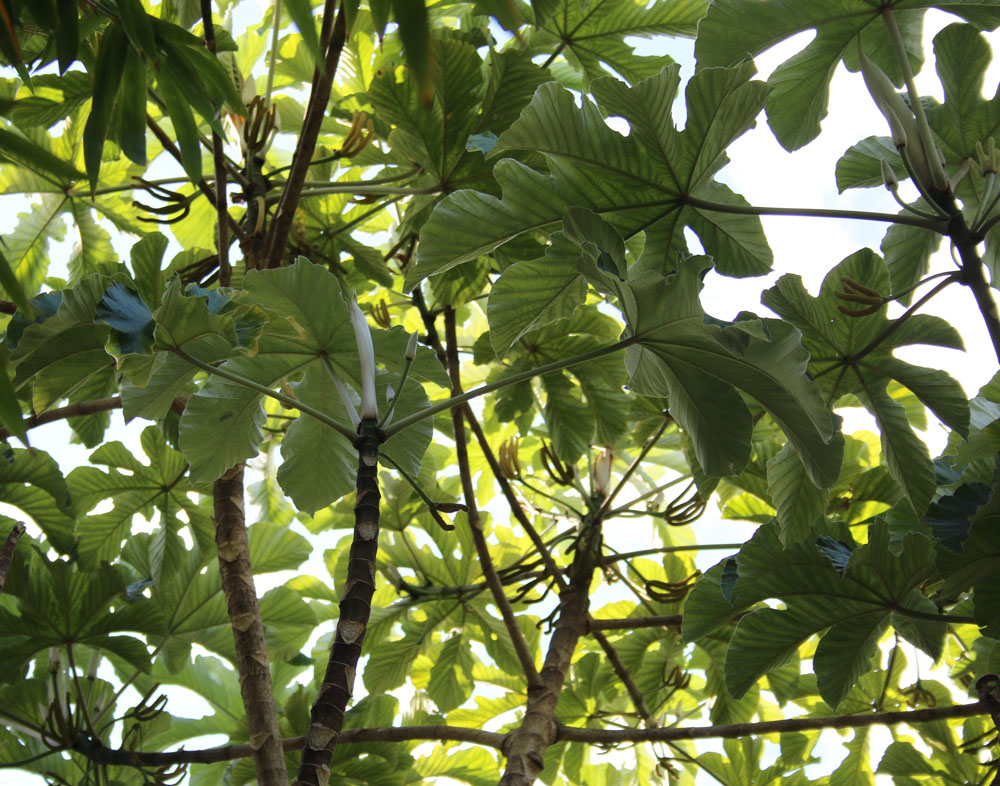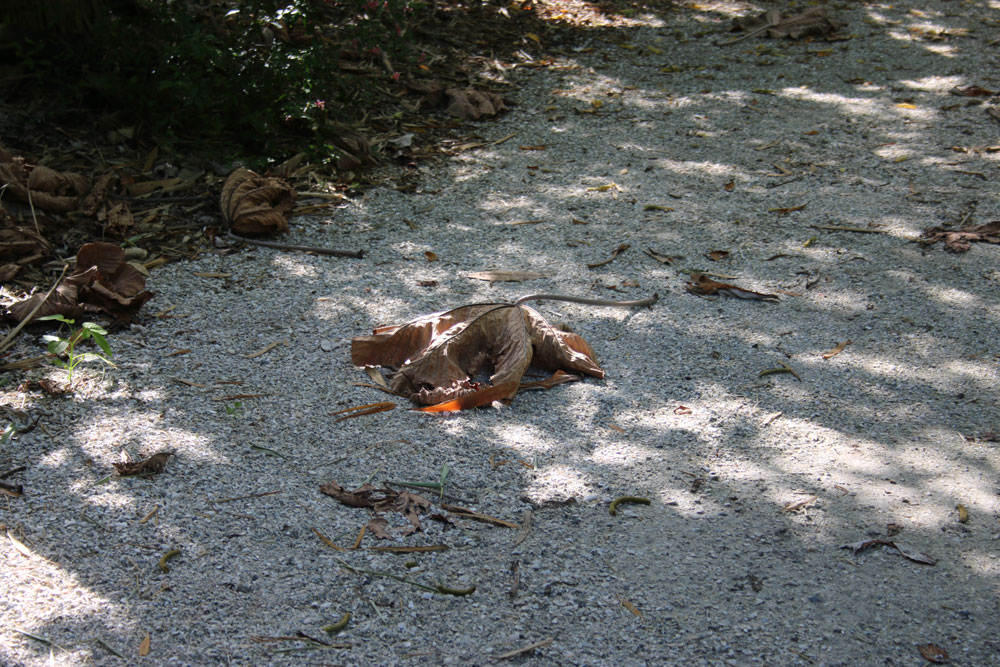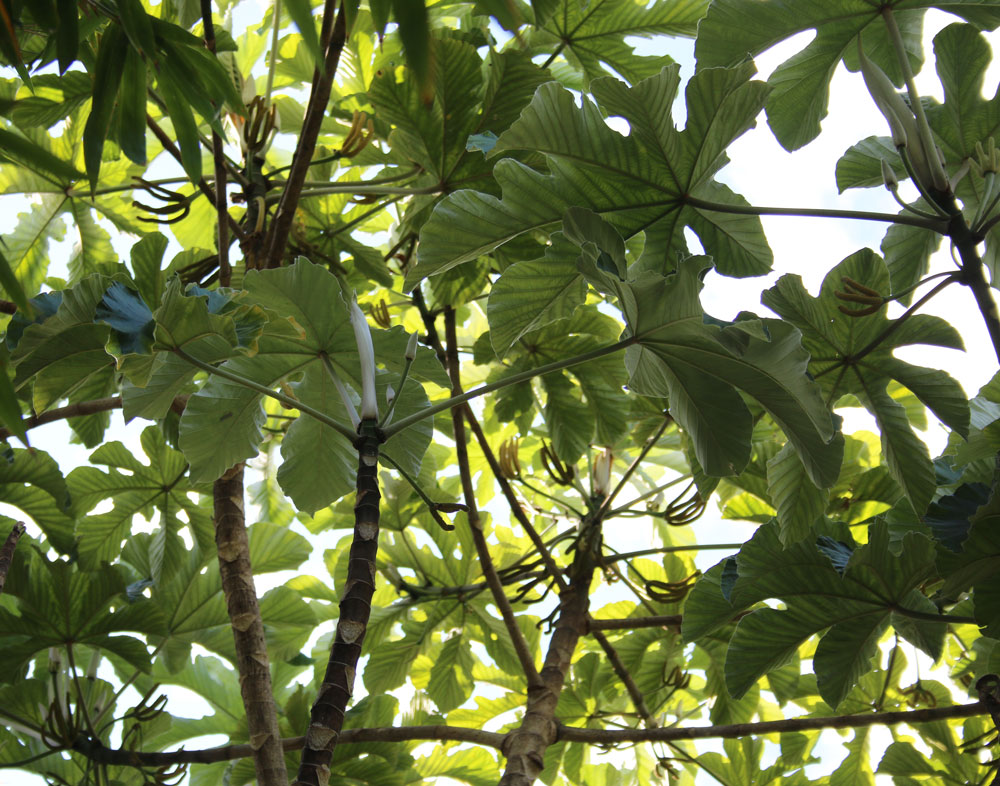
The Cecropia tree is one of my new favorite species.
When I visited the tropics a few years ago, I saw a large Cecropia tree growing in my friend’s pastureland and asked what in the world it was.
“Bacano tree,” he replied. “You can cut them down again and again to feed the goats whenever you’re short on forage.”
I looked up at this crazy, Dr. Suessian tree and wondered if it had any other uses. “Bacano” is just one of the many names for these genus of fast-growing trees. Others include
If you subscribe to my YouTube channel, you probably saw the little video from ECHO I posted a few weeks back where our tour guide was sharing some of the many uses of this incredible tree.
Here’s that quick video again:
Sandpaper, wood, animal fodder, edible fruit, tobacco substitute, quick shade, musical instruments, composting material, biomass for biochar… and it even has some medical uses.
It’s funny. People complain about trees dropping leaves all over their yards… but at ECHO they viewed the constant leaf drop as a plus.

As I wrote in Compost Everything: The Good Guide to Extreme Composting, it makes a lot of sense to plant fast-growing trees and plants just for the purpose of making compost. If you’re in a tropical climate, the Cecropia tree is a great choice.
I imagine it would make a great “nurse tree” for a tropical food forest, providing shade to younger trees along with a lot of chop-and-drop potential. The Cecropia tree is considered a “pioneer species.”
That means it’s one of the first plants to jump into a torn-up spot, bringing new life to damaged, eroded or burned areas. Pioneer species grow quickly and help shade and restore the soil so more finicky long-term species can return.
These are the sorts of trees you want at the beginning of a food forest.
When I start my next food forest, I’ll be adding Cecropia.
As it is, we have a few large Cecropia trees and some small ones here and there on our new homestead. Last week I tried some of the leaves as a tobacco substitute in my trusty Peterson’s briar pipe and found they tasted much like a decent English tobacco blend. Really good – much better than I expected, plus the smoke was quite smooth and non-irritating.
I tried chopping up a felled Cecropia in the bush with my machete and found the wood to be very, very hard. The stems are hollow, which has given me some ideas for future musical instruments…
…anyhow, as I stated in the title, this is really a useful tree. It’s a shame you can’t grow it in the temperate USA. I’ll bet you could pull them off in parts of California, Florida, Texas, Arizona and most definitely Hawaii… but for those of you in New Jersey, Oregon, etc., it’s not going to happen except in an amazingly huge greenhouse. And if I had enough money for one of those, I’d simply move to someplace warmer.


14 comments
I am watching p.b.s. world channel I had to put the period or else it come out pubs but back to my question is this tree good for a person with a blood disorder diabetes
Possibly.
“Berg and Rosselli stated that decoctions of leaves are made to stimulate the cardiac system, to treat asthma and pneumonia, to treat diabetes and as a diuretic. Powder of leaves is used for control of Parkinson’s disease and extract of roots is used to heal wounds or eczema.” -https://infogalactic.com/info/Cecropia
I am in Costa Rica and it is now the dry season. We have given our 1 year old cecropia (grown ourselves from seed) some water during this season but it has lost all its leaves. The stem is very green…will it come back? Should we water more?
I’ll bet it comes back. The leaves probably dropped in order to save water. If the ground is very dry, I would probably water more. I am not an expert on Cecropia, however.
I’m using them for shade, goat fodder, and mulch/biomass production in Hawaii. They go nuts here.
Of all the 100 species of Cecropia trees there is?
Are all the fruits from each tree edible?
The green finger looking things that grow from it which is the fruit?
Do you know if they’re all edible?
Also I read somewhere that the tree/fruit are used for candied preservatives?
Any info you know of they’re all edible.
I have 2 trees growing near me, but I know they’re 2 different species.
Any info will help, I wanna try the fruits so badly lol
The oh so useful cecropia tree is the headline of another one of us hippie type back to the landers story on cecropia. I simply googled it and it was one of the results. http://www.thesurvivalgardener.com/comment-subscriptions/?srek=e0128c1590854a3c4848134c58f9b330&srk=17e85d260b12a35daa7293a1f80da5e4
There is an ice cream bean tree also that my goat loves. The pods look like alien fruit or giant green to yellow to brown Halloween fingers. They are obviously related to Cherimoya. They look nothing like them, but the taste is near to exactly the same. The seeds look like great big Cherimoya seeds. They say they are eaten by people in South America where they originated, as did Cherimoyas.
Funny, I cannot paste in a photo.
I don’t know for sure, but the chickens and goats like the finger looking fruit of the cecropia. The link tells more, but I haven’t gone any further yet. My son noticed the similarity to fig in the seeds, and the leaves are vaguely similar to fig leaves. I also know here in Puna, on the Big Island of Hawaii, cecropias get gigantic, and fast. Just as one comment (here?, I forgot) said, they use them for extra fodder for the goats. Mine loves them. She often eats all the leaves, fruit, smaller stems, and at times she strips the bark off of them and eats that too.
Hey, thanks so much for this article on Cecropia. I noticed your link to the medicinal uses is no longer working, so I wanted to share this video I found from an herbalist in Belize, which might be useful as a jumping off point for some of your readers. https://youtu.be/bjJ67A1GqOg
Hello. Any resources on propagating, from seeds, cuttings, or air layering? We have a few cecropia on the property we recently purchased, but desire to reforest 50 degraded hectares of this 100 hectare finca in Ecuador, starting with cecropia and other pioneer species. But need more info on how to harvest and sow seeds, and other propagation methods. Thanks!!
I have not experimented with propagating them. They showed up spontaneously on broken ground when we lived in the tropical Caribbean. I wish I had more info.
I own a cecropia tree “gummy worm fruit”. How can you tell if it is male or female? I heard that you need to have a male and female tree in order to get fruit. Is that true? The one i have is growing like crazy in the pot.
I’m not sure. They grow super-fast.
Comments are closed.